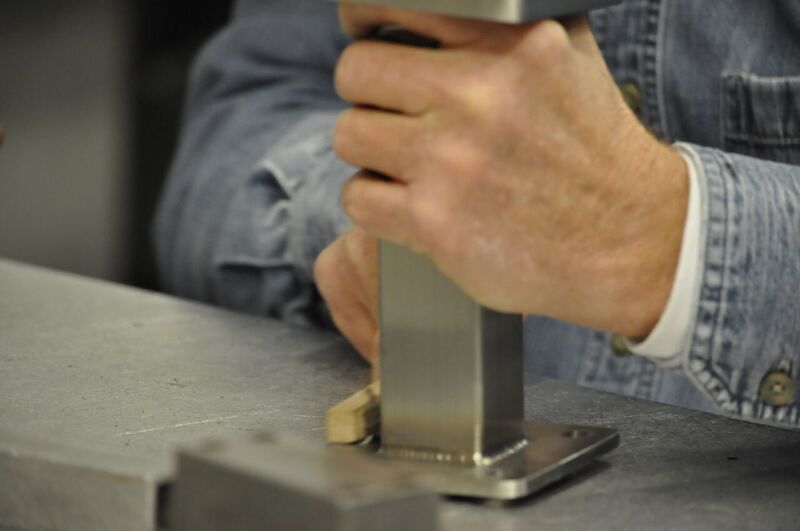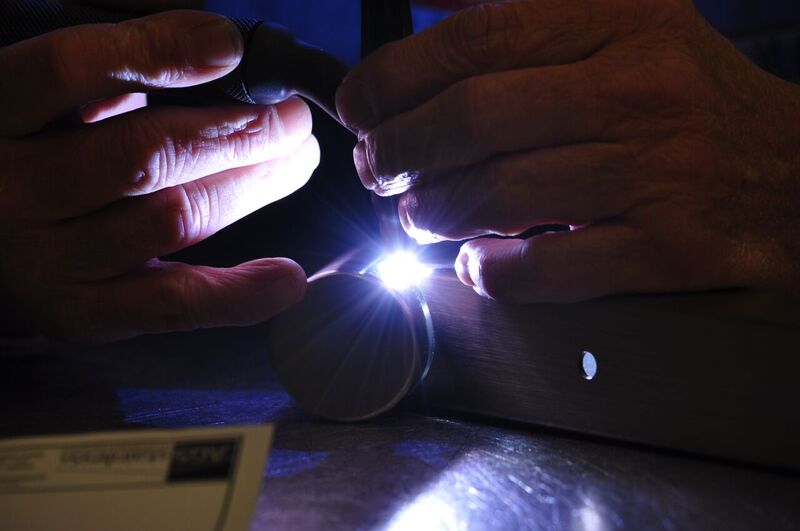One of the hallmarks of a custom-made railing system is high-quality welding. Typically, with custom-made railings there are no snap-on pieces; all the connections between the system components are welded. Although there are a number of metals used in the manufacture of railing systems, none can match the timeless beauty and ease of maintenance of stainless steel.
TIG-welding is used in the fabrication of stainless steel and at AGS Stainless we do all our TIG-welding by hand. This allows the craftsmanship of our artisan metal fabricators to shine through in each component of our railing system.
Want to know a bit more about our welding process? The following is a recent interview conducted with one of AGS’ artisan metal fabricators. With over 20 years’ of experience in metal fabrication, Patrick is a wealth of information on the subject.

Kevin: Patrick, how does TIG-welding differ from other types of welding?
Patrick: TIG-welding is more surgical in nature, more precise…more experience is required on the part of the fabricator than with MIG welding.
Kevin: Do you have a preference, prefab construction or onsite? Are there advantages to one over the other?
Patrick: I prefer prefabricated. Prefabrication generates a superior product.
Kevin: Why do you say that?
Patrick: There are a number of reasons. First of all, our railings do not require field adjustments.
Kevin: Can you explain what field adjustments are?
Most metal fabricators build their railings in their shop and then they do onsite adjustments, known as field modifications, to really “dial-in” the project in. I’ve done a lot of that work myself. Here at AGS though, the effort we put into the design process…before fabrication…really makes our product superior.
At AGS, we take the time to design the entire railing system in CAD, and only after we have literally built the entire railing system on paper first, do we move on to the fabrication process. This attention to detail in our design process ensures our railings will fit the project precisely, and it’s the reason absolutely no field adjustments (onsite cutting or welding) are required with our railings.
Patrick: Next, the environment. Within our factory, I have a clean environment to work in. This reduces the chances of contamination.
Kevin: Contamination?
Patrick: Cross-contamination of metals, which can lead to corrosion. There a lot of different metals present on a jobsite. The chances of cross-contamination are much higher when you’re welding onsite.
Patrick: Also, logistics are better with prefab.
Kevin: Logistics? You mean moving equipment around? How is that improved?
Patrick: Here in our factory I have everything I need, the right tools, the right tables, the right welder, the right materials. When you’re doing field modifications it’s not uncommon to discover you need a certain tool or a piece of equipment that you don’t have with you.
That means you can find yourself running back and forth to the shop to get it and that cuts into your efficiency. Also, when it comes to equipment, I know a lot of very talented fabricators who don’t have portable welding equipment, they have to rent it. These folks will build just about anything for you. A hood system for your gas range, an ornamental table, custom hardware for your doors and windows, etc.
In the industry we refer to them as job shops and most of these items can be built entirely in their shop. Many fabricators just don’t build enough railings each year to justify the cost of owning portable welding equipment. So, when they need this type of equipment they usually rent it.
And that’s assuming there is a suitable power supply for the portable welder at the site. Often times there is not, and that equipment must also be rented. These extra costs are always passed on to the customer.
Kevin: That’s really interesting.
Kevin: Patrick, let’s talk about the actual process of welding itself. What is the type of weld that you and the other AGS fabricators use to connect the post material to the plate when you are creating our top mount posts? It’s absolutely gorgeous and I have received so many compliments on it from building industry professionals.
Patrick: Thanks. What you’re looking at is a “fillet” weld. It’s a weld that occurs in a 90 degree intersection. At AGS we train our welders to do what’s referred to in the industry as a “row of dimes”.
With a fillet weld you actually add material to the weld. In addition to having all the intrinsic strength of the stainless steel post and base plate working for you, by adding addition stainless steel in the weld, we can make the connection between the two components even stronger.
If you think about it, the connection between the post and the base plate must be able to withstand all the lateral forces generated by people pushing against the top rail 3 or more feet away. That can be a considerable amount of flexion and that’s why we use that weld there, it provides extra strength.
Another advantage of prefabricating the railings is the quality of the finish is superior when it’s handled in a controlled environment.
Kevin: Well, Patrick, this has certainly been informative. Speaking on behalf of myself and all the AGS customers whose beautiful railings you and your co-workers have painstakingly crafted over these past 27 years – THANK YOU!
Click here to view the full image gallery, or learn more about AGS at AGSstainless.com.



